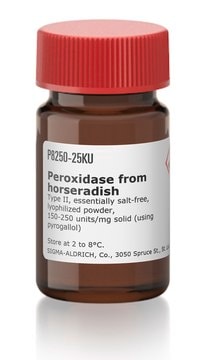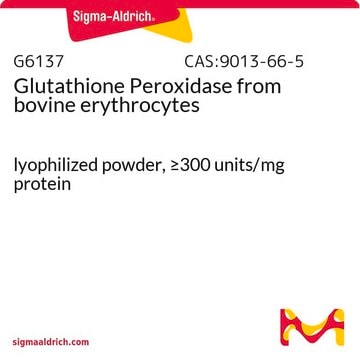S8409
Superoxide Dismutase from bovine liver
ammonium sulfate suspension, 2,000-6,000 units/mg protein (biuret)
Synonym(s):
SOD, Superoxide: superoxide oxidoreductase
Sign Into View Organizational & Contract Pricing
All Photos(1)
About This Item
Recommended Products
form
ammonium sulfate suspension
specific activity
2,000-6,000 units/mg protein (biuret)
mol wt
32.5 kDa
UniProt accession no.
storage temp.
2-8°C
Gene Information
cow ... SOD1(281495)
Looking for similar products? Visit Product Comparison Guide
General description
Research area: Cell Signaling
Superoxide dismutases are a group of low molecular weight metalloproteins present in all aerobic cells of plants, animals, and micro-organisms. They provide protection against damaging reactions with the superoxide radical anion (O2-) by catalyzing its disproportionation into oxygen and hydrogen peroxide.
Superoxide dismutases are a group of low molecular weight metalloproteins present in all aerobic cells of plants, animals, and micro-organisms. They provide protection against damaging reactions with the superoxide radical anion (O2-) by catalyzing its disproportionation into oxygen and hydrogen peroxide.
Application
Superoxide Dismutase from bovine liver has been used:
- for measuring mitochondrial hydrogen peroxide production in skeletal muscle
- as a positive control in Cu(II) binding stability assay
- as a positive control in superoxide dismutase assay
- in a study to assess the inactivation of endothelial-derived relaxing factor by oxidized lipoproteins.
- in a study to investigate the role of hydrogen peroxide in the cytotoxicity of the xanthine/xanthine oxidase system.
Biochem/physiol Actions
Superoxide Dismutase catalyzes the dismutation of superoxide radicals to hydrogen peroxide and molecular oxygen. It plays a critical role in the defense of cells against the toxic effects of oxygen radicals. It competes with nitric oxide (NO) for superoxide anion (which reacts with NO to form peroxynitrite), thereby SOD promotes the activity of NO. SOD has also been shown to suppress apoptosis in cultured rat ovarian follicles, neural cell lines, and transgenic mice.
Unit Definition
One unit will inhibit reduction of cytochrome c by 50% in a coupled system with xanthine oxidase at pH 7.8 at 25 °C in a 3.0 mL reaction volume. Xanthine oxidase concentration should produce an initial ΔA550 of 0.025 ± 0.005 per min.
Physical form
Suspension in 3.8 M (NH4)2SO4, pH 7.0
Analysis Note
For assay method, see McCord, J.M. and Fridovich,I., J. Biol. Chem., 244, 6049 (1969).
Signal Word
Danger
Hazard Statements
Precautionary Statements
Hazard Classifications
Resp. Sens. 1
Storage Class Code
10 - Combustible liquids
WGK
WGK 1
Flash Point(F)
Not applicable
Flash Point(C)
Not applicable
Personal Protective Equipment
dust mask type N95 (US), Eyeshields, Gloves
Certificates of Analysis (COA)
Search for Certificates of Analysis (COA) by entering the products Lot/Batch Number. Lot and Batch Numbers can be found on a product’s label following the words ‘Lot’ or ‘Batch’.
Already Own This Product?
Find documentation for the products that you have recently purchased in the Document Library.
Customers Also Viewed
Perturbed redox signaling exacerbates a mitochondrial myopathy
Dogan SA, et al.
Cell Metabolism, 28(5), 764-775 (2018)
Molybdenum application enhances antioxidant enzyme activity and COR15a protein expression under cold stress in wheat
Al-Issawi M, et al.
Journal of Plant Interactions, 11(1), 5-10 (2016)
J H Chin et al.
The Journal of clinical investigation, 89(1), 10-18 (1992-01-01)
Endothelial cell derived relaxing factor (EDRF) mediated relaxation of blood vessels is impaired in vessels exposed to lipoproteins in vitro and in arteries of hyperlipidemic humans and animals. To investigate the mechanism by which lipoproteins impair the effects of EDRF
E M Link et al.
The Biochemical journal, 249(2), 391-399 (1988-01-15)
1. The survival of mammalian epithelial cells exposed in vitro to the xanthine/xanthine oxidase system in phosphate-buffered saline (PBS) or serum-containing medium (SCMEM) was investigated. 2. The cytotoxic effect observed depended on the composition of the medium in which the
Exploiting the vulnerable active site of a copper-only superoxide dismutase to disrupt fungal pathogenesis
Robinett NG, et al.
The Journal of Biological Chemistry, jbc-RA118 (2018)
Our team of scientists has experience in all areas of research including Life Science, Material Science, Chemical Synthesis, Chromatography, Analytical and many others.
Contact Technical Service













